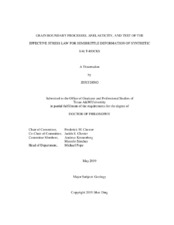| dc.description.abstract | In many natural and engineered systems, rock deforms by semibrittle flow that involves the coupled interaction of brittle and intracrystalline plastic micromechanisms. Synthetic salt-rock samples were prepared and deformed in the laboratory to investigate elastic and inelastic behavior, and to test the effective stress law during deformation in the semibrittle regime. The synthetic salt-rocks were fabricated by uniaxial consolidation of granular salt to produce two end-member types, an annealed, recrystallized, low-porosity, dry salt-rock, and a hardened, granular, porous, wet salt-rock. Triaxial cyclic deformation and stress-relaxation at a confining pressure of 1 MPa, room temperature, and strain rates of 3×10^-5 to 10^-9 s^-1 show that deformation occurs by intragranular cracking, grain boundary sliding and opening, and dislocation glide. Grain boundary opening develops preferentially in the loading direction, and increases in aperture and linkage with increasing inelastic deformation. Grain boundary sliding is predominantly a frictional process at high strain rates, but occurs by diffusion at low strain rates in wet samples. Activation of grain boundary sliding during semibrittle flow changes the elastic behavior by reducing the elastic modulus, increasing hysteresis, and increasing anelasticity at low differential loads, particularly in wet samples. The effective stress relationship was explored through isostatic consolidation and triaxial compression tests using argon and silicone oil as pore fluids, by varying pore fluid pressure while holding differential pressure constant. In all experiments, behavior was independent of the absolute value of pore fluid pressure, i.e., the effective stress coefficient, α, is one or nearly one. Analysis of grain contact area for both sliding boundaries and boundaries in contact by intracrystalline plastic yielding indicates that α is independent of the true area of grain contact. | en |


